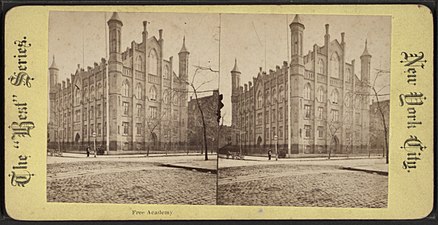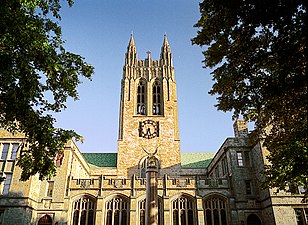Collegiate Gothic
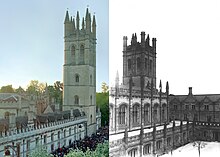
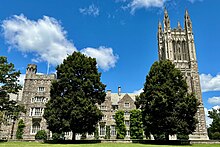
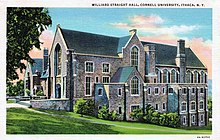
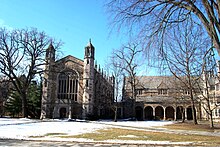

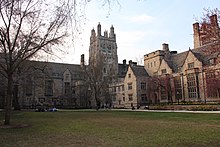

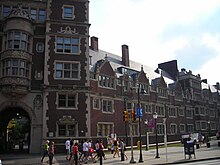
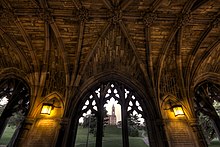
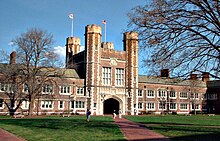

Collegiate Gothicis anarchitectural stylesubgenre ofGothic Revival architecture,popular in the late-19th and early-20th centuries for college and high school buildings in theUnited StatesandCanada,and to a certain extent Europe. A form ofhistoricistarchitecture, it took its inspiration from English Tudor and Gothic buildings. It has returned in the 21st century in the form of prominent new buildings at schools and universities includingCornell,Princeton,Vanderbilt,Washington University,andYale.[1][2]
Ralph Adams Cram,arguably the leading Gothic Revival architect and theoretician in the early 20th century, wrote about the appeal of the Gothic for educational facilities in his bookThe Gothic Quest:"Through architecture and its allied arts we have the power to bend men and sway them as few have who depended on the spoken word. It is for us, as part of our duty as our highest privilege to act...for spreading what is true."[3]
History[edit]
Beginnings[edit]
Gothic Revival architecture was used for American college buildings as early as 1829, when "Old Kenyon" was completed on the campus ofKenyon CollegeinGambier, Ohio.[4]Another early example wasAlexander Jackson Davis's University Hall (1833–37, demolished 1890), onNew York University'sWashington Squarecampus.Richard Bond's church-like library for Harvard College,Gore Hall(1837–41, demolished 1913), became the model for other library buildings.[5][6]James Renwick Jr.'s Free Academy Building (1847–49, demolished 1928), for what is todayCity College of New York,continued in the style. Inspired by London'sHampton Court Palace,Swedish-bornCharles UlricsondesignedOld Main(1856–57) atKnox CollegeinGalesburg, Illinois.[7]
Following theCivil War,manyidiosyncraticHigh Victorian Gothicbuildings were added to the campuses of American colleges. Examples includeWorcester Polytechnic Institute(Boynton Hall, 1868, byStephen C. Earle);[8]Yale College(Farnam Hall,1869–70, byRussell Sturgis); theUniversity of Pennsylvania(College Hall,1870–72, Thomas W. Richards);Harvard College(Memorial Hall,1870–77,William Robert WareandHenry Van Brunt); andCornell University(Sage Hall(1871–75,Charles Babcock). In 1871, English architectWilliam Burgesdesigned a row of vigorous French Gothic-inspired buildings forTrinity College–Seabury Hall, Northam Tower, Jarvis Hall(all completed 1878) – inHartford, Connecticut.[citation needed]
Tastes became more conservative in the 1880s, and "collegiate architecture soon after came to prefer a more scholarly and less restless Gothic."[9]
Movement[edit]
Beginning in the late-1880s, Philadelphia architectsWalter CopeandJohn Stewardsonexpanded the campus ofBryn Mawr Collegein an understated English Gothic style that was highly sensitive to site and materials. Inspired by the architecture ofOxfordandCambridgeuniversities, and historicists but not literal copyists, Cope & Stewardson were highly influential in establishing the Collegiate Gothic style.[10]Commissions followed for collections of buildings at theUniversity of Pennsylvania(1895–1911),Princeton University(1896–1902), andWashington University in St. Louis(1899–1909), marking the nascent beginnings of a movement that transformed many college campuses across the country.
In 1901, the firm ofShepley, Rutan & Coolidgecreated a master plan for a Collegiate Gothic campus for the fledglingUniversity of Chicago,then spent the next 15 years completing it. Some of their works, such as the Mitchell Tower (1901–1908), were near-literal copies of historic buildings.
George Browne Postdesigned theCity College of New York's new campus (1903–1907) atHamilton Heights, Manhattan,in the style.[citation needed]
The style was experienced up-close by a wide audience at the 1904Louisiana Purchase ExpositioninSt. Louis, Missouri.TheWorld's Fairand1904 Olympic Gameswere held on the newly completed campus ofWashington University,which delayed occupying its buildings until 1905.[citation needed]
The movement gained further momentum whenCharles Donagh MaginnisdesignedGasson HallatBoston Collegein 1908. Maginnis & Walsh went on to design Collegiate Gothic buildings at some twenty-five other campuses, including the main buildings atEmmanuel College(Massachusetts), and the law school at theUniversity of Notre Dame.[citation needed]
Ralph Adams Cramdesigned a series of Collegiate Gothic buildings for thePrinceton University Graduate College(1911–1917).
James Gamble Rogersdid extensive work atYale University,beginning in 1917. Some critics claim he tookhistoricistfantasy to an extreme, while others choose to focus on what is widely considered to be the resulting beautiful and sophisticated Yale campus.[11]Rogers was criticized by the growingModernistmovement.[12]His cathedral-likeSterling Memorial Library(1927–1930), with itsecclesiasticalimagery and lavish use of ornament, came under vocal attack from one of Yale's own undergraduates:
A modern building constructed for purely modern needs has no excuse for going off in an orgy of meretricious medievalism and stale iconography.[13]
Other architects, notably John Russell Pope and Bertram Goodhue (who just before his death sketched the original version of Yale's Sterling Library from which Rogers worked), advocated for and contributed to Yale's particular version of Collegiate Gothic.[14][15]
WhenMcMaster Universitymoved toHamilton, Ontario,Canadian architectWilliam Lyon Somervilledesigned its new campus (1928–1930) in the style.[citation needed]
Origins of the term[edit]
American architectAlexander Jackson Davisis "generally credited with coining the term"[16]documented in a handwritten description of his own "English Collegiate Gothic Mansion" of 1853 for the Harrals of Bridgeport, Connecticut.[17]By the 1890s, the movement was known as "Collegiate Gothic".[18]
1904 commentary[edit]
In his praise for Cope & Stewardson'sQuadrangle Dormitoriesat theUniversity of Pennsylvania,architectRalph Adams Cramrevealed some of the racial and cultural implications underlying the Collegiate Gothic:
It was, of course, in the great group of dormitories for the University of Pennsylvania that Cope and Stewardson first came before the entire country as the great exponents of architectural poetry and of the importance of historical continuity and the connotation ofscholasticism.These buildings are among the most remarkable yet built in America...
First of all, let it be said at once that primarily they are what they should be: scholastic in inspiration and effect, and scholastic of the type that is ours by inheritance; ofOxfordandCambridge,not ofPaduaorWittenbergorParis.They are picturesque also, even dramatic; they are altogether wonderful in mass and in composition. If they are not a constant inspiration to those who dwell within their walls or pass through their "quads" or their vaulted archways, it is not their fault but that of the men themselves.
The [Spanish-American War Memorial] tower has been severely criticized as an archaeological abstraction reared to commemorate contemporary American heroism. The criticism seems just to me, though only in a measure. American heroism harks back to English heroism; the blood shed beforeManilaand onSan Juan Hillwas the same blood that flowed atBosworth Field,Flodden,andthe Boyne.Therefore the British base of the design is indispensable, for such were the racial foundations.[19]
Culmination[edit]
Collegiate Gothic complexes were most often horizontal compositions, save for a single tower or towers serving as an exclamation.
At theUniversity of Pittsburgh,Charles Klauder was commissioned byUniversity of PittsburghchancellorJohn Gabbert Bowmanto design a tall building in the form of a Gothic tower.[20]What he produced, theCathedral of Learning(1926–37), has been described as the literal culmination of late Gothic Revival architecture.[21]A combination of Gothic spire and modern skyscraper, the steel-frame, limestone-clad, 42-story structure is both the world's second tallest university building and Gothic-styled edifice.[22]The tower contain a half-acre Gothic hall supported only by its 52-foot (16 m) tall arches.[23]It is accompanied by the campus's other Gothic Revival structures by Klauder, including theStephen Foster Memorial(1935–1937) and the French GothicHeinz Memorial Chapel(1933–1938).
21st-century revival[edit]
A number of colleges and universities have commissioned major new buildings in the Collegiate Gothic style in recent years. These include Princeton University'sWhitman College,designed byPorphyrios Associates,andBenjamin Franklin CollegeandPauli Murray College,both designed byRobert A.M. Stern Architects,at Yale University.[24]The University of Southern California's USC Village[25]was created as an inexpensive post-modern nod to collegiate revival. (Harley Ellis Devereaux, 2017).
Architects of the Collegiate Gothic style[edit]
- Julian Abele
- Snowden Ashford
- Allen & Collens
- Cope & Stewardson
- Ralph Adams Cram
- William Augustus Edwards
- Philip H. Frohman
- Bertram Grosvenor Goodhue
- Charles C. Haight
- Guilbert and Betelle
- William Burges
- Charles Klauder
- Pond and Pond
- George Browne Post
- James Gamble Rogers
- Horace Trumbauer
- Dan Everett Waid
- David Webster
- York and Sawyer
Examples[edit]
This sectionneeds additional citations forverification.(May 2015) |
- Abyssinian Baptist Church– Abyssinian Baptist Church[26]
- Altgeld's castles– a set of buildings within five Illinois universities (1896–1899)
- Augustana College (Illinois),Rock Island, Illinois– The Old Seminary, the Ascension Chapel, and Founders Hall (1923)
- Berry College– Ford buildings
- Boğaziçi University- South Campus (previously known asRobert College), Turkey (1863)
- Boston College– specifically Gasson Hall, Devlin Hall, St. Mary's Hall, and Bapst/Burns Library
- Bryn Athyn CathedralofBryn Athyn College
- Bryn Mawr College– Pembroke Hall (1894)[27]
- Carleton College
- Central Commerce Collegiate/Central Toronto Academy,Toronto(1916)
- Central Technical School,Toronto
- City College of New York(1903),George Browne Post,architect
- College of Wooster– Kauke Hall
- Columbia University: Teachers College
- Cornell University
- Danforth Collegiate and Technical Institute,Toronto (1922–1923)
- Dobbs Ferry High School,Dobbs Ferry, New York (1934)
- Drew University,S.W. Bowne Great Hall (1912).[28]
- Duke University–Duke Chapel(1930–1935), and West Campus, arch.
- East York Collegiate Institute(façade only), Toronto (1927)
- Eastern Commerce Collegiate Institute,Toronto, Canada (1925)
- Eastern Senior High School(1923), Washington, D.C.[29]
- Emma Willard School
- Florida State University
- Fordham University–Rose Hill Campus[30][31]
- Fordson High School,Dearborn, Michigan
- Franklin & Marshall College–Old Main, Goethean Hall, and Diagnothian Hall(1854–1857)
- Georgetown University–Healy Hall(1877-1879)
- Georgia Tech
- Grinnell College
- Harbord Collegiate Institute(1932), Toronto
- High Point Central High School(1926), (High Point, North Carolina)
- Hillsborough High School (Tampa, Florida)
- Indiana University-Bloomington
- Isaac E. Young Middle School,New Rochelle, New York
- John Carroll University
- John Marshall High School,Los Angeles,California
- Kenyon College
- Knox College– Old Main (1857)[7]
- Lehigh University
- Loretto Abbey Catholic Secondary School– Toronto (1927)
- Loyola University Maryland
- Loyola University New Orleans–Marquette Hall(1910)
- McGill University,Montreal, Canada
- McKinley High School,St. Louis, Missouri
- McMaster University,Hamilton,Ontario, Canada
- The Mary Louis Academy,Jamaica Estates, New York (1937)
- Melbourne High School,Melbourne, Australia – the Twenties Building[32]
- Michigan State University
- Milliken Public School, Markham – façade only (1929)
- Mimico High School,Toronto (1924) – now occupied by John English Middle School
- New Jersey Institute of Technology– Central King Building, the old Central High School of Newark (1911)
- North Toronto Collegiate Institute1912 – demolished
- Northwestern University
- Northwest Missouri State University– Administration Building
- Oakwood Collegiate Institute,Toronto (1911)
- Oglethorpe University,Atlanta, Georgia
- Park Vista,Seattle, Washington (1928)
- Parkdale Collegiate Institute,Toronto (1929)
- Princeton University– Blair Hall (1896)[33]
- Providence College– Harkins Hall (1917)
- R. H. King Academy,Toronto (formerly Scarborough High School/Collegiate Institute) – partially demolished and main entrance arch from original building remains (1922)
- Reed College,Oregon
- Rhodes College,Memphis, Tennessee
- Runnymede Collegiate Institute,Toronto (1927)
- Purdue University
- St. John's UniversityJamaica, New York. St. John Hall and St. Augustine Hall.
- Saint Joseph's University,Philadelphia, Pennsylvania[34]
- Sewanee: The University of the South,Sewanee, Tennessee
- Trinity College,Connecticut
- United States Military Academy,West Point, New York
- University of Arkansas
- University of Chicago
- University of Denver
- University of Florida
- University of Idaho
- University of Iowa
- University of Michigan–Law Quadrangle(1923–33),Martha Cook Building(1915)
- University of Notre Dame
- University of Oklahoma
- University of Pennsylvania–Quadrangle Dormitories(1894–1911),[35]Medical School(1904, 1928),Veterinary School and Hospital(1906, 1912),Law School(1900)
- University of Pittsburgh(Cathedral of Learning,Heinz Chapel,Stephen Foster Memorial,Clapp Hall)
- University of Richmond,Virginia
- University of St. Thomas,Minnesota
- University of Saskatchewan,Canada
- University of Southern California– Wallis Annenberg Hall
- University of Tennessee at Chattanooga
- University of Toledo– University Hall and Memorial Field House, Ohio
- University of Toronto– St. George campus, Canada
- University of Washingtonin Seattle –Suzzallo Library(1926)
- The University of Western Ontario,London,Ontario, Canada
- Vanderbilt University–E. Bronson Ingram College,[36]
- Vassar College
- Washington University in St. Louis–Brookings Hall(1900), and theDanforth Campus
- Virginia Polytechnic Institute and State University
- Wesleyan University
- West Chester University
- Western Technical-Commercial School,Toronto (1927)
- Weston Collegiate Institute/Vocational School (1923) – demolished and replaced by a modern building
- Williams College,Thompson Memorial Chapel
- Worcester Polytechnic Institute— Boynton Hall (1868)[8]
- Yale University–Sterling Memorial Library,Harkness Tower,and theMemorial Quadrangle;arch.James Gamble Rogers.
- York Memorial Collegiate Institute,Toronto (1929)
Gallery[edit]
-
University Hall (1833–37),New York University,Alexander Jackson Davis,architect.
-
Free Academy Building (1847–49),City College of New York,James Renwick Jr.,architect.
-
College Hall(1870–72),University of Pennsylvania,Thomas W. Richards, architect.
-
Shephard Hall tower (1903–1907),City College of New York,George Browne Post,architect.
-
Gasson Hall,Boston College
-
Holder Hall,Princeton University(1909–1911).
-
Suzzallo Library(1922–1926),University of Washingtonin Seattle,Charles BebbandCarl F. Gould,architects
-
Heinz Chapel(1933–1938),University of Pittsburgh,Charles Klauder, architect.
See also[edit]
References[edit]
- ^"College campuses are constructing buildings that look like they're straight out of Harry Potter's world".Los Angeles Times.2017-12-21.Retrieved2023-02-03.
- ^"Brookings Hall".Washington University in St. Louis.Retrieved2023-02-03.
- ^Slipek, Edwin J. Jr., Ralph Adams Cram, The University of Richmond and the Gothic Style Today, Marsh Art Gallery, University of Richmond, 1997 p. 19
- ^Rev. Norman Nash designed the building. ArchitectCharles Bulfinchwas asked to review the plans, and designed the steeple. Marjorie Warvelle Harbaugh, "Charles Bulfinch",The First Forty Years of Washington DC Architecture,(Lulu, 2013), p. 362.[1]
- ^Daniel Coit Gilman, "The Library of Yale College",The University Quarterly(October 1860), p. 9.[2]
- ^Kenneth A. Breisch,Henry Hobson Richardson and the Small Public Library in America,(MIT Press, 1997), p. 60.
- ^ab"Old Main".Knox College.Archived fromthe originalon December 24, 2013.RetrievedJune 11,2015.
- ^ab"The WPI Campus".WPI Tech Bible.Worcester Polytechnic Institute.Retrieved26 November2020.
The impressive academic Gothic Revival structure that Earle designed is believed to be the first gothic collegiate building in the United States. Thus, this Institute is proud to claim that the tradition of gothic "old main" college buildings in America started with Boynton Hall.
- ^Lewis,The Gothic Revival,p. 185.
- ^"Collegiate Gothic".Bryn Mawr Library. Archived fromthe originalon 2019-03-03.Retrieved2010-03-28.
- ^Paul Goldberger, "Architecture and New Haven", International Festival of Arts and Ideas, New Haven, June 24th, 2010http:// paulgoldberger /lectures/architecture-and-new-haven/
- ^Paul Goldberger, "The Sterling Library: A Reassessment",On the Rise: Architecture and Design in a Post Modern Age,(Penguin Books, 1985), pp. 269–71.
- ^William Harlan Hale, "Yale's Cathedral Orgy",The Nation(April 29, 1931), pp. 471–72.
- ^Bloomer, Kent C. (2000). The Nature of Ornament: Rhythm and Metamorphosis in Architecture. New York: W. W. Norton & Company. pp. 187–185.ISBN9780393730364.Retrieved 4 April 2014.
- ^bl326 (August 7, 2013)."John Russell Pope and the Unrealized Yale Campus Plan".Manuscripts and Archives Blog.Yale University Press.RetrievedJuly 18,2018.
{{cite web}}:CS1 maint: numeric names: authors list (link) - ^Truettner, Julia M. (31 December 2002).Aspirations for Excellence: Alexander Jackson Davis and the First Campus Plan for the University of Michigan, 1838.University of Michigan Press. p. 49.ISBN0472112775.Retrieved16 March2018.
- ^Golovin, Anne Castrodale."Bridgeport's Gothic Ornament The Harral-Wheeler House"(PDF).Smithsonian Institution.Smithsonian Institution Press.Retrieved16 March2018.
- ^Regain, Melissa (2011). Marter, Joan M. (ed.).The Grove Encyclopedia of American Art, Volume 1.Oxford University Press. p. 362.ISBN9780195335798.Retrieved16 March2018.
- ^Ralph Adams Cram, "The Work of Messrs. Cope and Stewardson",The Architectural Record,vol. XVI, no. 5 (November 1904), pp. 414–15, 417.[3]
- ^Bowman, John G. (1963), "Wanted: A Drawing",Unofficial Notes,Pittsburgh, pp. 48–50,OCLC2572578
{{citation}}:CS1 maint: location missing publisher (link) - ^Trump, James D. (August 25, 1975)."National Register of Historic Places Inventory – Nomination Form: Cathedral of Learning"(PDF).Pennsylvania's Historic Architecture & Archaeology. Archived fromthe original(PDF)on October 20, 2014.RetrievedMarch 6,2022.
...in the literal sense of the word, Late Gothic Revival architecture culminated in the University of Pittsburgh's skyscraping Cathedral of Learning. (Marcus Whiffen,architecture historian)
- ^"Cathedral of Learning, Pittsburgh".SkyscraperPage.Retrieved2012-12-07.
- ^Toker, Franklin (2009).Pittsburgh: A New Portrait.Pittsburgh, PA: University of Pittsburgh Press. p. 327.ISBN978-0-8229-4371-6.
- ^Stern, Robert A. M.; Shapiro, Gideon Fink (2018).The New Residential Colleges at Yale: a Conversation Across Time.Paul Goldberger, Melissa DelVecchio, Graham S. Wyatt, Arianne Kouri. New York, New York: Monacelli.ISBN9781580935043.OCLC986817299.
- ^"USC Village".USC – University of Southern California.RetrievedOctober 8,2018.
- ^Abyssinian Baptist Church.Abyssinian Baptist ChurchAbyssinian Baptist Church. 2020.ISBN978-0-19-977291-9.RetrievedOctober 21,2020.
- ^"Collegiate Gothic – Cope and Stewardson".Bryn Mawr CollegeLibrary Special Collections. 2001. Archived fromthe originalon March 3, 2019.RetrievedJune 11,2015.
- ^"Bowne Hall - Drew University History - U-KNOW".Archived fromthe originalon 2020-09-30.Retrieved2020-12-31.
- ^"Replace or Modernize? The Future of the District of Columbia's Endangered Old and Historic Public Schools: Eastern Senior High School"(PDF).21st Century School Fund. May 2001.Retrieved2 January2014.
- ^Venturi, Dan."Fordham University Church".Fordham University.RetrievedDecember 15,2013.
- ^Jacobs, Peter (October 11, 2013)."Tour Fordham University's Stunning Campus In The Bronx".Business Insider.RetrievedJune 22,2017.
- ^"Melbourne High School".Victorian Heritage Directory.Heritage Council Victoria. 2009.Retrieved2018-12-31.
- ^"Orange Key Virtual Tour: Blair Hall".Princeton University.Archived fromthe originalon September 24, 2015.RetrievedJune 11,2015.
- ^"History of SJU | Saint Joseph's University".sju.edu.Retrieved2017-03-25.
- ^"Virtual Tour of Penn's Campus: The Quadrangle".University of Pennsylvania.Archived fromthe originalon September 24, 2005.RetrievedJune 11,2015.
- ^Keith, Katherine."E. Bronson Ingram College receives LEED Gold certification".Vanderbilt University.
Sources[edit]
- Bergin, T. G.Yale's Residential Colleges; the First Fifty Years.New Haven, CT: Yale University Press, 1983.
- Duke, Alex.Importing Oxbridge.New Haven: Yale University Press, 2006.ISBN0300067615
- Lewis, Michael J.,The Gothic Revival(London: Thames & Johnson Ltd., 2002).ISBN0-500-20359-8
- Robinson, Deborah and Edmund P. Meade. "Traditional Becomes Modern: the Rise of Collegiate Gothic Architecture at American Universities."Conference paper presented at 'Second International Congress on Construction History', Queens' College, Cambridge University; 2006.
External links[edit]
 Media related toCollegiate Gothic architectureat Wikimedia Commons
Media related toCollegiate Gothic architectureat Wikimedia Commons


